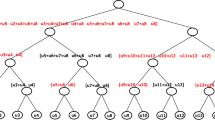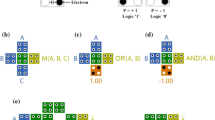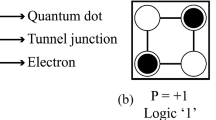Abstract
Recently, the synthesis of reversible sequential circuits has attracted researchers’ attention for implementing low-power logic designs. So far, the direct and replacement techniques have been used in the reversible sequential circuits design. The replacement technique leads to high quantum cost. There is the principle to look for efficient reversible circuits composed of Clifford + T gates by optimizing quantum cost, the number of T gates, and particularly the T-depth of the circuit, which depends on the type and layout of the reversible gates used in the function. This paper has proposed an optimized version of direct feedback technique without any flip-flops and is performed on several samples of reversible circuits design, such as counters and shift registers. It has been shown that by partial changes in the direct technique, quantum cost and other cost metrics have been improved. It has also displayed some efficient designs of the reversible parallel-to-serial converter with parity capability and low-cost design of the control unit for a reversible self-controlled serial adder system. The analysis and comparison depict that all new proposed designs have optimized the existing works in terms of performance variables, including quantum cost, number of T gates, and T-depth of the circuit.



























Similar content being viewed by others
References
Landauer R (1961) Irreversibility and heat generation in the computing process. IBM J Res Dev 5(3):183–191
Bennett CH, Landauer R (1985) The fundamental physical limits of computation. Sci Am 253(1):48–57
Kotiyal S, Thapliyal H, Ranganathan N (2015) Reversible logic based multiplication computing unit using binary tree data structure. J Supercomput 71(7):2668–2693
Babu HMH, Mia MS, Biswas AK (2017) Efficient techniques for fault detection and correction of reversible circuits. J Electron Test 33(5):591–605
Toffoli T (1980) Reversible computing. International colloquium on automata, languages, and programming. Springer, pp 632–644
Nashiry MA, Bhaskar GG, Rice JE (2015) Online testing for three fault models in reversible circuits. In: 2015 IEEE International Symposium on Multiple-Valued Logic IEEE, pp 8–13
Kalantari Z, Eshghi M, Mohammadi M, Jassbi S (2019) Low-cost and compact design method for reversible sequential circuits. J Supercomput 75(11):7497–7519
Khan MH, Rice JE (2018) First steps in creating online testable reversible sequential circuits. VLSI Design. https://doi.org/10.1155/2018/6153274
Khan MH (2013) Design of reversible synchronous sequential circuits using pseudo Reed-Muller expressions. IEEE Trans VLSI syst 22(11):2278–2286
Nashiry MA, Rice JE (2019) Achieving fault tolerance in reversible computing. Int J Sci Eng Res 10(5):52–56
Nashiry MA, Rice JE (2017) A reversible majority voter circuit and applications. In: 2017 IEEE Pacific Rim Conference on Communications, Computers and Signal Processing (PACRIM) IEEE, pp 1–6
Nashiry, MA. Khan, MH. & Rice, JE. (2017). Controlled and uncontrolled swap gates in reversible logic synthesis. In International Conference on Reversible Computation, Springer, Cham, pp 141–147
Handique M, Biswas S, Deka JK (2019) Test generation for bridging faults in reversible circuits using path-level expressions. J Electron Test 35(4):441–457
de Almeida AA, Dueck GW, da Silva AC (2018) Efficient realizations of CNOT gates in IBM’s quantum computers. In: 2018 8th International Symposium on Embedded Computing and System Design (ISED) IEEE, pp 58–62
Miller DM, Wille R, Sasanian Z (2011) Elementary quantum gate realizations for multiple-control Toffoli gates. In: 2011 41st IEEE International Symposium on Multiple-Valued Logic IEEE, pp 288–293
de Almeida AA, Dueck GW, da Silva ACR (2019) Efficient realization of toffoli and ncv circuits for IBM QX architectures. In: International Conference on Reversible Computation, Springer, Cham. pp 131–145
Gaur HM, Singh AK, Ghanekar U (2015) A review on online testability for reversible logic. Proced Comput Sci 70:384–391
Mohammadi M, Eshghi M (2009) On figures of merit in reversible and quantum logic designs. Quantum Inf Process 8(4):297–318
Jayashree HV, Thapliyal H, Arabnia HR, Agrawal VK (2016) Ancilla-input and garbage-output optimized design of a reversible quantum integer multiplier. J Supercomput 72(4):1477–1493
Arabzadeh, M. Zamani, M. Sedighi, M. & Saeedi, M. (2011). Logical-depth-oriented reversible logic synthesis. In Proceedings of the International Workshop on Logic and Synthesis.
Thapliyal H, Munoz-Coreas E, Varun TSS, Humble T (2019) Quantum circuit designs of integer division optimizing T-count and T-depth. IEEE Tran Emerg Top Comput. https://doi.org/10.1109/TETC.2019.2910870
Zulehner, A. Paler, A. & Wille, R. (2018). Efficient mapping of quantum circuits to the IBM QX architectures. In 2018 Design, Automation Test in Europe Conference Exhibition (DATE)
Abdessaied N, Amy M, Soeken M, Drechsler R (2016) Technology mapping of reversible circuits to Clifford+ T quantum circuits. In: 2016 IEEE 46th international symposium on multiple-valued logic (ISMVL) IEEE, pp 150–155
Thapliyal H, Srinivas MB, Zwolinski M (2005) A beginning in the reversible logic synthesis of sequential circuits.
Fredkin E, Toffoli T (1982) Conservative logic. Int J Theor Phys 21(3–4):219–253
Nayeem NM, Hossain MA, Jamal L, Babu HMH (2009) Efficient design of shift registers using reversible logic. In: 2009 International Conference on Signal Processing Systems IEEE, pp 474–478
Thapliyal H, Ranganathan N (2010) Design of reversible sequential circuits optimizing quantum cost, delay, and garbage outputs. ACM J Emerg Technol Comput Syst 6(4):1–31
Khan MH, Perkowski M (2011) Synthesis of reversible synchronous counters. In: 2011 41st IEEE International Symposium on Multiple-Valued Logic IEEE, pp 242–247
Khan MH, Rice JE (2016) Improved synthesis of reversible sequential circuits. In: 2016 IEEE International Symposium on Circuits and Systems (ISCAS) IEEE, pp 2302–2305
Qi X, Zhu H, Chen F, Zhu J, Zhang Z (2016) Novel designs of quantum reversible counters. Int J Theor Phys 55(11):4987–4998
Krishnaveni D, Priya MG (2017) A novel reversible n–bit counter for low power quantum computing. Int J Control Theory Appl 10:11–20
Maity H, Biswas A, Bhattacharjee AK, Pal A (2018) Quantum cost optimized design of 4-bit reversible universal shift register using reduced number of logic gate. Int J Quantum Inform 16(02):1850016
Noorallahzadeh M, Mosleh M (2019) Efficient designs of reversible latches with low quantum cost. IET Circuits Devices Syst 13(6):806–815
Nashiry, MA. (2017). Synthesis, testing and tolerance in reversible logic (Doctoral dissertation, Lethbridge, Alta.: University of Lethbridge, Dept. of Mathematics and Computer Sciences).
Miller, D. M., Soeken, M., & Drechsler, R. (2014, July). Mapping NCV circuits to optimized Clifford+T circuits. In International Conference on Reversible Computation, Springer, Cham. pp 163–175
Author information
Authors and Affiliations
Corresponding author
Additional information
Publisher's Note
Springer Nature remains neutral with regard to jurisdictional claims in published maps and institutional affiliations.
Rights and permissions
About this article
Cite this article
Kheirandish, D., Haghparast, M., Reshadi, M. et al. Efficient designs of reversible sequential circuits. J Supercomput 77, 13828–13862 (2021). https://doi.org/10.1007/s11227-021-03735-2
Accepted:
Published:
Issue Date:
DOI: https://doi.org/10.1007/s11227-021-03735-2




